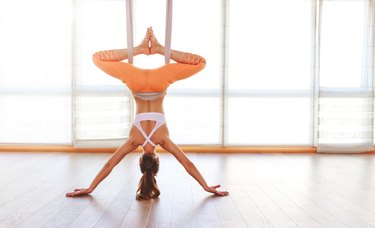
Inversions are regularly practiced in yoga for their ability to relieve stress, elongate the spine and aid the body's circulatory system; inversion tables provide similar benefits, without having to balance on your head or hands.
While securely strapped onto the table, you tilt yourself upside down to your desired degree. Once there, you can stretch or perform exercises without any pressure being placed on your spine. Of course, simply hanging upside down and relaxing is always an option.
Video of the Day
Video of the Day
Use of an inversion table can also reduce back pain. According to a small study published in January 2012 in the journal Disability and Rehabilitation, use of an inversion table results in a significant reduction in the need for surgery to treat lumbar disc protrusion.
Read more: Do Inversion Tables Help with Neck Pain?
How to Begin
Adjust the inversion table to your height; your head should rest comfortably on the bed of the table and not hang over the edge. Read the directions carefully when adjusting your table since each manufacturer may use different mechanics.
Decide the degree to which you want to invert. Beginners may want to start with the board at a slant, such as at 90 degrees rather than a full 180 degrees; increase the degree of the inversion gradually as you acclimate to being upside down. Many inversion tables come with a safety strap that allows you to choose your inversion degree; adjust the strap to your particular preference.
Secure and Invert
Stand with your back against the table and place your feet in the footrests. Follow your table's directions for securing your feet. Lean back to rotate the table to invert. Hold onto the handles if applicable. Move slowly rather than dropping back quickly.
Breathe deeply, inhaling through your nose and exhaling through your mouth, as you hang upside down and relax. Stay inverted for as long as you are comfortable. Beginners may find it disconcerting to be upside down at first; consider inverting for just two to three minutes to start and gradually work your way up to 10 to 20 minutes as you become more comfortable.
Inversion Table Exercises
Once you are accustomed to being upside down, add some inversion table exercises. Stretch your back while you are inverted on the table. Engage your abdominal muscles and slide the shoulder blades down your back. Reach your hands toward the ground behind your head so that your arms are straight and your spine is elongated. Hold the stretch for as long as you feel comfortable, though aim for at least 30 to 60 seconds.
Strengthen your abs by performing crunches while you are inverted. Place your hands behind your head with your elbows pointing out toward the sides. Pull your abdominal muscles in toward your spine and slide the shoulder blades down your back. Lift your head, shoulders and upper back up off the table; you should feel a contraction in your abs. Hold the lift for one count and then return to starting position. Repeat for three sets of 12 to 15 crunches.
Pull yourself up with the handles when you are ready to return to an upright position. Rotate very slowly to avoid feeling dizzy. Wait until you feel steady before unlocking the foot rests and stepping out of the inversion table.
Read more: Pros and Cons of Inversion Tables
Inversion Table Risks
While being inverted can be beneficial for back discomfort, there are also inversion table risks, including increased pressure in the eyes, increased blood pressure and slowed heart rate. According to Mayo Clinic, individuals with high blood pressure, heart disease or glaucoma should not use these devices.
- MyInversionTable.com: "Inversion Table Exercises and Stretches"
- MyInversionTable.com: "How to Use an Inversion Table – Basic Mechanics"
- Mayo Clinic: "Inversion Therapy: Can It Relieve Back Pain?"
- Disability and Rehabilitation: "Inversion Therapy in Patients With Pure Single Level Lumbar Discogenic Disease: A Pilot Randomized Trial"